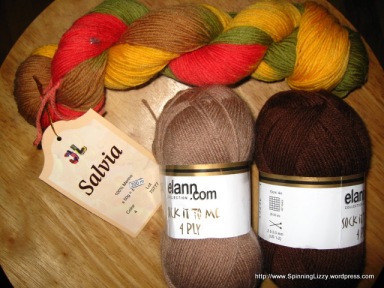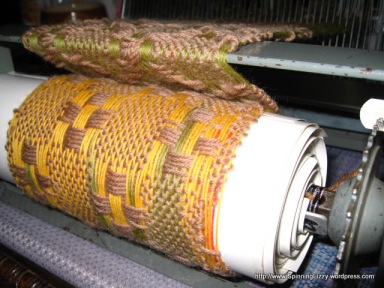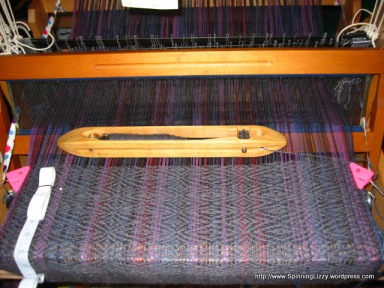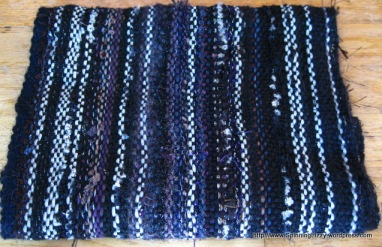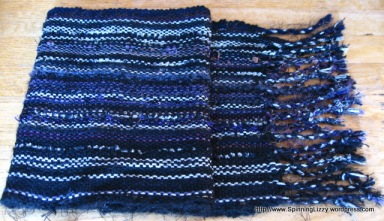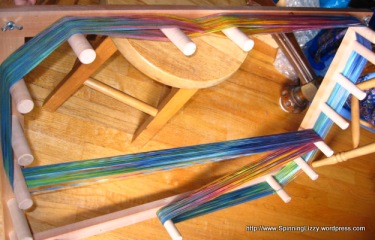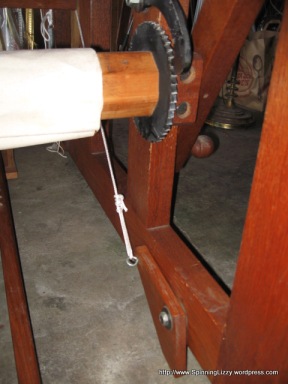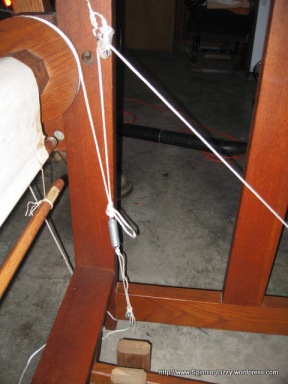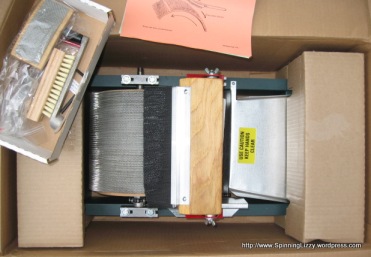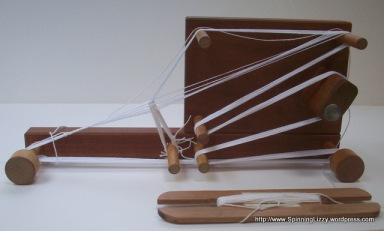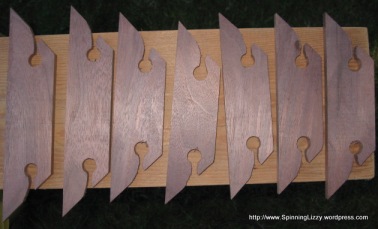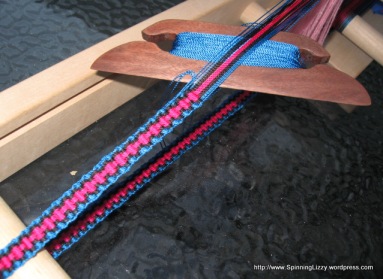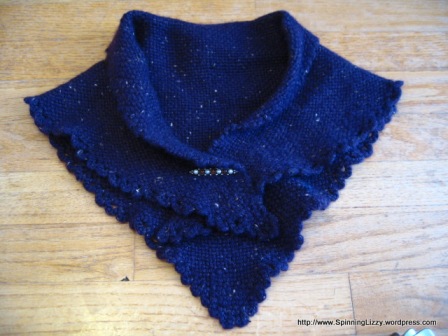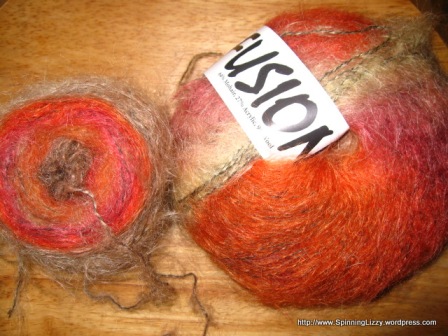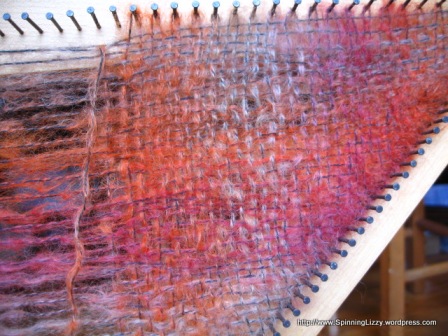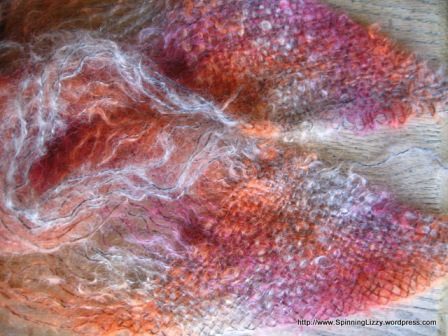Slow-Process Beautiful Crafts
Yikes! It’s been years since my last post. These days, I’m mostly knitting with the occasional spinning, although I wish that were reversed.
By the magic of stumbling across unrelated things over the internet, I happened on this video by vlogger Liziqi, and wanted to share. Absolutely adore the little animals who follow her like Snow White!
Rasmussen Tie-Up Photo Post
Hi Everyone!
I’ve had many requests for tie-up details concerning the Rasmussen loom. I made the mistake a few years ago of over-tightening the cords that lead to the treadles. This resulted in a decreased shed. I’ve been dragging my heels on correcting that problem, so haven’t used the loom for at least three years! (And I really miss it!)
The loom is buried under lots of other things, as the quick remodel we had envisioned has stretched on much longer than we anticipated. Everything has to move from one room to another while work is being done, then moved yet somewhere else for the next job!
Without further ado, the pictures. (To see details, click for large size.)
Good luck with your Rasmussen loom!
Not A Happy Camper
Dear Reader,
It’s been two years since my last post, not for lack of words, but time. Looking in my draft folder, I find I have almost a dozen posts in various stages of completeness. A friend urged me: “Just publish them, even without photos!” So here is my first post without photos. I’ll try to find time down the line to add them in…
This post was mostly written six years ago:
Eight years ago, when I learned how to spin on a drop spindle, I was very sure it was adequate for my needs, and I did not ask anyone in my spinning group to let me try out their spinning wheel. What would be the point, if I never needed a wheel?
So, when I realised the error of my ways (within a couple months!), my first time trying out a spinning wheel at a store was also my first time sitting at a wheel. That wheel was a Louet Victoria, and I learnt enough, an hour later, (learning to spin on my own, as the store kindly left me to my own devices), to determine that the Victoria was too small and expensive for my needs.
At another store, I tried out a Lendrum DT, and thought it spun very well; after having cut my teeth on the Victoria, it was too easy, and… shouldn’t there be more pain and learning curve to this learning process?! The saleswoman at that store mentioned the existence of walnut Lendrums, in the “they’re not available, to anyone” tone of voice, sniff sniff. I have no idea why she brought up the subject, as I had never paid attention to Lendrum wheels, any sort of Lendrum, prior to that day, and certainly didn’t know enough to ask. I didn’t purchase a wheel that day, because Lendrums were backordered with a wait-time of up to a year. But, to be honest, the price of a new wheel was also too far beyond my thinking as to what I wanted to spend.
I began to pay attention to advertisements for second-hand wheels, and my first was the trusty Ashford Traditional. After a month-long flirtation with the Traddie, I found, purely by luck, a walnut anniversary Lendrum DT in an essentially unused, new condition!
The Traddie was fun, but wasn’t fun to tote around in the car, to spinning meets. It had come with only the basic ratios, so I had to decide if wanted to spend the extra money to upgrade the Traddie, or put that money into a more modern wheel. I sold the Traddie, due to lack of space. (I have to laugh now, as I look around at the looms eating up every available inch of room!) The Lendrum was easier to go out with, and life was grand. Why did people need more than one wheel, anyway?!
A few months later, I met some new spinners at a fibre day at a wool-processing mill — and saw another walnut Lendrum! I asked the owner how long she had had hers (I don’t know why I assumed she had acquired hers second-hand, as I did), she looked to at the golden plaque (found on the front of all walnut anniversary Lendrums) and told me, “since they came out in 2001”. (By the way, I wasted ten minutes searching the internet to come up with that year, before padding the few paces down the hallway to check out my own!) I was aghast. Her walnut was faded, dented, and generally looking like an aged beauty whose best days were clearly in the past, nothing like the deep, glossy shine of my own. Is that what happens to a walnut Lendrum that goes everywhere? When it rained at the end of a spinning workshop I took, taught by Judith MacKenzie-McCuin (JMM), she helped me put a plastic cover over the top of my wheel, which stuck out a few inches from my makeshift spinning-wheel bag (a canvas artist’s box-easel backpack). When JMM said, “you need to be extra careful with walnut in the rain; any water drops that get on it will leave spots on the wood,” the days of leaving the house with my Lendrum became numbered.
I thought I could muddle through by getting a proper carrying bag for it. But I couldn’t stomach the expense of a new bag (used bags were simply not available!), which wouldn’t cost me less than $100, but probably closer to $150. But even for that price, I couldn’t find a trim and tailored bag that met all my requirements. My easel-box bag was both those things, except for the two inches of wheel it failed to cover, and except when it rained. (Ha! I live in the drizzly Pacific Northwest.) I would make my own bag, I thought. I’m not proficient at sewing anything but straight lines, but I thought I could do it. After spending many hours designing the bag, I psyched myself out at the prospect of sewing curves, and couldn’t bring myself to make the first cut into the the fabric I acquired for the project.
It also became apparent to me that, at close to fourteen pounds (more, with accessories), the Lendrum pushes the limit of easy portability, although its bulk, rather than weight, is the greater encumbrance. I needed a smaller wheel. But, not just any smaller wheel. I also needed high ratios, because anything slower than 20:1 means I wouldn’t enjoy spinning long-draw. There’s a charming, ultra-portable wheel called the Pocket Wheel, but it maxes out at a low 13:1 — a starting point ratio for me.
Then in 2009 February, a solution presented itself to me in the form of a Louet S45. The previous owner bought it new, but had barely used it. It took me a couple of months to tweak it by replacing the two ball-bearings on the flyer and a crosspiece with two spring-mounted bearing balls (used as a lazy kate to mount bobbins); but it soon spun perfectly. It’s a little dynamo, and an engineering marvel, with the only drawback of maxing out at a ratio of 20:1.
The S45 flyer assembly with thread guides is simply genius. After I grew accustomed to using the delta flyer, I truly appreciated the ease of threading the flyer.
A ball bearing on either side holds the bobbin in place for plying. I talked to Louet, and they said the inner measurement of the bobbin was engineered to be 1mm smaller on one side, specifically so that the bobbin would stay in place. Amazing craftsmanship!
For a travelling bag, I found a collapsible, soft-sided food cooler with rolling cart from Costco for $20. The S45 is squat and pyramidal, and does not require any extra time to set up. I find it very useful at home, as I can easily tote it to any spot where I want to spin. The Lendrum is parked in its little nook, too unwieldy to move about in my crowded house, but always ready when I want to use the VFF.
The Lendrum’s Very Fast Flyer (VFF) includes a respectable 44:1 ratio, but in general I’m afraid to treat myself to using it. Recently, I spent several hours spinning laceweight singles with the VFF, but afterwards couldn’t get my S45 to work properly spinning something similar; I thought it was somehow broken. Investigation showed that I had mistakenly set the Lendrum’s VFF at 44:1 rather than 26:1; and the S45’s upper limit of 20:1 just couldn’t compete. It took a bit of retraining, spinning lots of thick singles, for me to be happy with the slower wheel again. Spinning frequently on the Louet S45, I discovered what well-built, rock-solid construction it has.
The S45 in a rolling cooler bag was supposed to set me free, but I had problems when I towed it over three blocks of clean city sidewalks. I pulled my back out of alignment, and it took a visit to my doctor to straighten that out. When I found that the S45 was no longer being manufactured, I felt again the same angst of owning another wheel that could not be easily replaced. And again, (being completely neurotic), I could not enjoy bringing it out to spin in public where it might be assaulted by an unlucky event (a raindrop, sticky fingers, a harsh glance…).
What does this have to do with camping? Sometime during the days before having a child, I made a somewhat vague, if rash, promise to go camping if we had a son, on the premise that it is supposedly a rite of passage into manhood. (Now that I think of it, I don’t think it was actually a promise, more a capitulation under duress…) Our son has now lived eleven years without having undergone that dreaded ritual (although I did agree to backyard camping this summer, and have suffered through three summers of cub scout day camp), and the noose is closing about my neck. Let me clarify this by stating that I am a city person and homebody, and my idea of camping would be staying at almost any other place than home. To make matters worse, I think I may have also agreed to something about fishing. Frankly, I don’t see the point. There’s so much else I want to do, and, having a child (definition: force of nature into which all time and energies gravitate), so little time. There’s simply not enough time for me to sit at a lake in the middle of nowhere, dangling a sacrificial worm impaled on a hook tied to a line attached to a stick on the off-chance that some hapless fish might laugh so hard at the setup that he’ll decide to commit suicide. I don’t even like to eat fish, and besides, there are these things called supermarkets… And don’t get me started on flying and biting insects. I seem to broadcast “bug bait” from every pore.
Before you think I’ve gone loopy with this digression, I am actually trying to get somewhere. In my family, I am the one who is relied upon to assemble or install anything, from toys to bicycles and software. We have a GPS on loan to us from a friend; while it would be wonderful for my husband to use it to find his way home on his own (I rarely get lost, and don’t really need it), it would require his actually exerting himself to turn it on and input an address. Here’s a true story: Once, I fell asleep on a subway ride from New York City to the airport. I woke when I heard the announcement that we were nearing the end of the line, at Rockaway. I was astonished that we were at the farthest point away from our destination, having boarded the train going the wrong direction, and that it would take more than an extra hour to backtrack and reach the airport. My husband had such belief in my navigational ability, he never questioned our route, even though we were sitting directly across from a subway map! Another true story: After living in Seattle for several years, and having in that time had occasion to travel both north to Canada and south to Portland numerous times (it’s different directions on the same highway), I once fell asleep right after leaving our house, and again awoke to find that my husband had been blissfully driving to Portland when our destination was Canada! Try as I might, I have not been able to dispell the myth pervading our family that my presence would be needed to provide shelter (set up a tent), sustenance (find the ignition switch on the campstove), and navigate our way home from camp (follow the exit signs from the parking lot). My attempts to negotiate a loophole or moratorium to this impending camping/fishing nightmare has only resulted in the concession that a portable spinning wheel might well smooth the way toward my not being completely unbearable company during such an outing.
The S45, being slightly chunky, as well as difficult to replace, loses it status as a portable wheel that wouldn’t make me more neurotic from protecting its pristine excellence. So, in 2010, I was forced!, to order another spinning wheel, a Louet Victoria, and I had to order it brand-new. Brand-new prices are simply unbelievable (again, I was forced!), with steep depreciation for resale, while used-wheel prices keep their value very well. Because I wanted the oak rather than beech model, I had to wait a month after ordering it to receive it. Just before ordering it, I came across a little-used, oak Victoria with high-speed kit for a decent price, but because Vics that were made more recently have some improvements that models older than eight years do not have, DH insisted on the purchase of a new one to forestall any renegotiations on my part.
The last Vic I saw in person, made of beech, was the one I first tried one out at a store, years ago. Since receiving my own oak Vic, I am surprised to see so much variation in appearance from one oak wheel to the next; due, I suppose, to its its oak veneer over MDF (medium density fibreboard) construction. I’ve seen other oak Vics which I did not consider beautiful (again, the chance of veneer), although I am happy to say I love mine. I wonder if the beech Vics also have as much variance.
The Vic is small, and has the awesome mechanical construction I’ve come to expect in a Louet. It’s top ratio of 20:1 is similar to the the S45, although the S45 is a more stable and solid spinner. At ten pounds, it’s still not as lightweight as I’d like, but there are no other (non-electrical!) options available that would be an improvement. I have taken the Victoria with me as carry-on baggage on an international trip, and found it travelled beautifully, albeit still a bit heavily. I’m happy to say it went through Seattle-Tacoma TSA security with flying colours. The two TSA agents examining the x-ray took their time, and one asked me, as if to settle a bet, “Is it a spinning wheel?” I was relieved not to have to take the wheel out to prove it!
As the third wheel in my house, I keep the Vic always in its carrying case, so I can grab it and run out the door at a moment’s notice. How lazy is that?! It’s a great portable wheel, although I don’t think it’s the perfect wheel for camping.
With ever-more affordability of battery choices, it seems that a small electric spinner might be the most portable route, but I don’t think I can push my luck. Especially since I’ve recently rediscovered how much fun spinning on a drop spindle is. There is such a Zen to spinning, and I’ve been enjoying it even at the drop spindle’s leisurely and rustic pace. Which is more than I can say for camping.
Huck Scarf On The Structo Loom
For the past school year, I wove huck scarves as teacher-appreciation gifts. I truly thought I had posted about these scarves long ago, but I couldn’t find any evidence of that. I find it a bit alarming that I accepted as fact something I must have dreamed up. How much of what I believe to be true came from a dream? Is this a symptom of being too busy?!
From my stash of sock yarns, I found some Salvia superwash merino that had been dyed in the skein.
Since the dyers had not re-wound the skein, it was easy to determine the length of yarn for a colour repeat.
Taking advantage of that colour repeat, I wound a warp in a continuous circle to preserve the dye patterning for a “faux ikat” warp.
I used all eight shafts of my little Structo loom for this huck pattern.
The brown weft at the beginning didn’t appeal to me, plus the scarf was too long to wear comfortably.
So, I cut off the beginning for a sample.
The only drawback to this pattern is that it leaves long warp floats on the two selvedges.
The wool is superwash, so I was surprised that the scarves did shrink a little. They were very fast to weave on the Structo; with its solid, all-steel construction, the loom is an amazing performer with impressively smooth and precise tensioning.
64 ends, sleyed 2 per dent on a 6-dent reed
5.33″ on-loom width
Finished dimensions 4.5″ x 74″ + 10″ twisted fringe (one scarf plus sample),
or two scarves, each about 44″ long + 7″ twisted fringe
4-block huck, #672, Carol Strickler’s Weaver’s Book Of 8-Shaft Patterns
Alpaca Shawl On The Rasmussen Loom
I had an ugly warp on my Rasmussen loom for the longest time. I was keen to to cut off and throw it away as soon as I’d made the decision to do it, but it still took me more than two years to to actually perform the deed.
Undergoing another spate of cleaning up the house and looking for easy things to give away, I thought I would re-gift some alpaca yarn that Syne Mitchell gave me. The warps had already been wound and cut, but there was no cross. The weft was four skeins dyed in slightly different shades of grey.
I didn’t think I wanted to spend the time to tame the warp, so put the yarn aside for several weeks, meaning to pass it along when the moment presented itself. But every time I passed by the yarn sitting on the top of my “to-do” pile, I was struck by the beautiful colours of the warp. It would not be fun to untangle the warp and re-define a cross, but it would be a good lesson to work through, so why shouldn’t I give it a try?
Working in groups of six or eight warps from the bundle at a time, I painstakingly drew out each warp and lay it on my floor to create a new cross. I had no idea what original colour sequence was intended, so all the warps were placed in the random order they were drawn in.

I had to repair several broken warps, but the rest of the project went smoothly. I do have to tune up my Rasmussen’s attachment to the treadle stand before the next project, as the heddle eyes pulled the warps down below the the height at the front and back beams.
The different shades of weft really stood out in the finished shawl. I also had issues with consistent beating, something compounded by the slightly imprecise ratchet and pawl tensioning of the Rasmussen loom, the friction of the cloth going over the front beam while being wound onto the cloth beam, and the elapse of several weeks between each weaving session. I hand-washed and fulled the shawl in hot water, and the resulting cloth is heavy, dense, and very warm.
Woven on Rasmussen 4-shaft loom with direct tie-up treadles
Warp & weft: unknown alpaca yarn, estimated 24 wpi, sett at 10 epi
Pattern: Undulating Twill, Point Draft 2/2 twill from
Anne Dixon’s Handweaver’s Pattern Directory
224 warp ends, each 105″ in length, for total 653 yards
580 yards of weft used
Taken off loom: 19.5″ width x 83″ woven length, plus more for fringe
Final, post-wash and full dimensions: 18-3/8″ x 79-1/4″ + 12″ fringe
First Flip Projects
I’ve had a Schacht 15″ Flip rigid heddle loom for a while, but didn’t start using it until last winter. Because my dining table has a beveled edge that won’t allow me to lean a rigid heddle loom against, I’ve had to wait until I could put the Flip on a floor stand. Having finally cleared off an uninspiring project claiming my older Schacht (non-folding) RH loom for the better part of two years, I could finally take that loom off the trestle stand and install the Flip in its place. The Flip is built to accept two heddles, and to fold over. However, using it at home, I’ve never had to need to fold it. Perhaps this might be an issue with the larger Flip.
My first project was a way to use up a horde of partially-used novelty yarns left over from other projects. I decided to use them as warp, and had my first try at direct warping. It was so much trouble, it took me four days to wind and beam the warp on. Some of the novelty threads had bobbles and slubbs that had difficulty advancing though the heddle openings. Others were mohair and similarly hairy yarns that refused to give me a clean shed. Few of the warps were of the same material, so tensioning was a nightmare.
I had to open every shed with a weaving sword, and hand-pick problem warps. I thought my troubles with the slubby, bobbly yarns were over after dressing the loom, but I had forgotten that the warp needed to be advanced while weaving, and the heddle had to be used for beating! I allowed the fiddly-ness of advancing the warp, but I gave up on using the heddle to beat the weft, using a tapestry fork instead. I caught some float errors, but there were more that I didn’t catch. Somehow, the fussy work I had to put in did not bother me, perhaps because I thought the yarns were so beautiful. (Having said that, I won’t attempt something like this again any time soon!) Even after finishing, the two long sides differ by several inches in length. Faults and all, I still like this scarf. I’m looking forward to this winter’s cooler weather to try it out.
After that first project, I wanted to put on an easy warp for quick and mindless weaving. I warped the loom with some skinny alpaca, and used the slubby Colinette Point-Five yarn for weft. The weather had been very cold while I planned this scarf, so I designed the scarf wide as well as long, resulting in a scarf a bit on the heavy side; it reminds me of a table runner! I just wish the Point-Five yarn were as soft as the alpaca. This project was extraordinarily satisfying, in that the finished scarf closely resembles what I imagined during the planning stage, and I encountered absolutely no problems (tension, sett, broken warps, etc.) during weaving. This is the first time that has happened for me!
Having woven heavy and warm, I wanted to weave a summery cotton scarf. I had two colourways of Colinette Wigwam hand-painted cotton tape in Jewel and Raspberry. I thought of how I tend toward the cautious, using the less-liked of things first (and sometimes never getting around to the more pleasing choice), and decided to be a little wild (for me!) and use the jewel-tones first. Poor decision! I squandered the jewels to find out that this yarn shrinks somewhere between 30-to-40 percent, so the jewel scarf turned out too short. I wound the warp in a circular pattern around the warping board, as faux-ikat, to preserve the alignment of the colours as they were painted.
The other mistake I made with this warp was not to take the extra time to untwist and flatten the cotton tape as I wound it. The twists do detract from the looks after finishing, especially on the selvedges.
Weft was 3/2 mercerised perle cotton, black for Jewel, and white for Raspberry. I think the black made Jewel look reptilian, and the white made Raspberry look pink. I also had all sorts of beat inconsistencies, making these scarves very unprofessional-looking. If I had the power of do-over, I would find some dark blue-ish weft for Jewel, and use a dark grey for the Raspberry. I wasn’t happy with the way both of these projects turned out, so they have already been recycled as very expensive dust cloths!
I really love the looks of the solidly-built loom, and look forward to future projects using more than one heddle. I can also see that I might have to devise some sort of trap/tray to add on at some later point.
Mini Inkle Loom
I’ve been wanting to follow the tutorials in Laverne Waddington’s book, “Andean Pebble Weave” since I brought it home earlier this year.
I could have put a warp onto my Schacht inkle loom, but because my attention span is so short nowadays due to the increasingly numerous homeschooling events and schedule I have to juggle, I wanted a small inkle loom that I could warp quickly and throw into my backpack.
Enter the new-to-me Good Wood mini-inkle loom. This loom measures 12″ long, 3.25″ wide, and 5.25″ high.
My loom came thoughtfully pre-warped with a white cotton warp, which couldn’t hold my interest after a foot of weaving, so I took it off. I put on a warp of crochet thread, but the colours were so pale that I couldn’t see the pebble weave design.
It only took a few inches of weaving for me to decide I didn’t want to spend any more time on this warp, either. Besides, I had warped it incorrectly, and while it still worked, it offended my type-A sensibilities.
Warping it “incorrectly”, one can wind 51″ of warp on the loom, while with “correct” warping, one gets only 49″ of warp length. Perhaps it’s better to do things the wrong way sometimes.
For some reason, I thought I read in Ms. Waddington’s book that carpet warp was to be avoided. I re-read her recommendations again, and could not find a single word decrying it. Carpet warp I have in spades, although of course I chose from the oddments of my collection rather than break into unopened spools. It’s my default weakness — always choosing from leftovers rather than deliberately breaking into the “good” stuff. But with this tiny loom, I’m finding it easy to change my mind about what I dress it with, as anything I take off is miniscule.
(Notice I still have not been able to throw them away yet!
This loom is so small that I had trouble keeping the doupe heddles from falling off the doupe dowels I had been using. A few small barrettes solved the problem, and were less cumbersome besides.
The pattern is so much easier to see with this combination of colours.
The dowels on this mini inkle loom measure only 3/8″ in diametre, so tensioning can be taut but I think one must still have a care not to overtighten the warp. Overall, I’m very pleased with the small footprint, portability, and cuteness factor of this tiny loom.
ETA: In my hurry to post, I had completely forgotten that I meant to comment on Ms. Waddington’s book. I’m only on the first tutorial, but already I love the way the techniques are presented. The steps she has you follow make following ones more intuitive, and the pictures are wonderful. A couple of instances after I had read and followed the steps, I thought “but what happens if…”, only to find that she answered the questions on the next page. I’ve often admired Andean pebble weave as something beautiful but far too complex, but this book dispels that assumption, and this might be the first weaving book I’d work through from cover to cover.
Inkle Shuttles
I recently purchased some pre-cut, but unfinished, inkle shuttles made of walnut wood.
The woman I bought them from told me that that it had taken her husband an hour each to hand-sand a beveled edge and finish with tung oil. I hoped that, with the benefit of an orbital sander and a cheapo Dremel-tool knockoff, I would be able to finish my seven shuttles more quickly. Not so! It took me closer to an hour-and-a-half to finish each of them, and I could tell soon after I started that I’m not meant to be a professional woodworker. I wish I had more skill to have done a better rough sanding of the beveled edges, because some of the sanding marks still show on the wood.
It took a lot of extra time, without the benefit of electric tools, with fine- and ultra-fine-grit sandpaper to smooth out some of the rougher sanding marks. I was in a hurry to finish while I still had the momentum to spur me on, but even so, it took intensive work every day of this past three-day Labor Day weekend to finish. Hand-sanding, rubbing with oil, drying, sanding, more oil, more drying, more sanding, oil… it seemed to never end! By the third day, I had only to look at a piece of sandpaper for my fingers to go numb; my hands and arms were so sore!
But sore hands could not stop me from planning a quick inkle project, using Omega nylon thread:
I warped a Schacht inkle loom with its maximum warp, which produced a woven length of approximately 96″, plus 8″ of loom waste. This strap is 1/2″ wide.
When I checked the prices of inkle shuttles online, I was appalled at how low they were — I would starve before I could make a living doing this!








